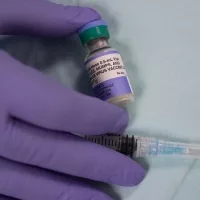
(WASHINGTON) — The Centers for Disease Control and Prevention (CDC) is updating its recommendations for testing, treatment and protection for workers who may be exposed to animals infected with bird flu.
The update comes after the agency found evidence of dairy workers with positive antibodies, suggesting more bird flu infections that previously reported, according to a new report released Thursday afternoon.
Serologic testing, which looks at antibodies in the blood, found that eight out of 115 workers, or 7%, who were exposed to bird flu during outbreaks among cows at dairy farms in Michigan and Colorado had evidence of recent infection.
All eight workers said their jobs included either milking cows or cleaning a milking parlor. Four workers recalled experiencing symptoms, mainly conjunctivitis, also known as pink eye. The remaining four patients said they did not experience symptoms when the cows were ill.
As a result, the CDC said it is updating its guidance addressing who should be tested for bird flu to include workers who were exposed to bird flu and do not have symptoms.
“There may be individuals infected but who do not recall having symptoms,” Dr. Nirav Shah, the CDC’s principal deputy director, told reporters during a media call Thursday morning. “That means we need to cast a wider net in terms of who is offered a test.”
Secondly, the CDC is now recommending offering oseltamivir – a prescription medication to treat influenza that’s often marketed under the name Tamiflu – to asymptomatic workers who have experienced high-risk exposure to animals infected with bird flu and who did not wear adequate personal protective equipment (PPE).
Shah said a high-risk exposure event could include a splash in the face with raw cow milk, or a culling event without PPE being worn.
He added that the Tamiflu treatment recommendation both reduces asymptomatic cases from becoming symptomatic because they are being treated, and reduces the risk of infected individuals spreading the virus to close contacts.
Lastly, the Shah said the CDC was changing its PPE guidance for workers.
Although the risk of bird flu transmission from dairy cows to humans Is low, the CDC said there have been few reports addressing how PPE is used during work activities on dairy farms.
The new CDC report said the Colorado Department of Public Health and Environment (CDPHE) and the Colorado Department of Agriculture (CDA) offered PPE to all Colorado farms before or during the bird flu outbreak in cows in 2024.
When asked if they had access to PPE before a bird flu outbreak, 88% of workers reported access to gloves, 76% reported access to eye protection such as safety glasses or goggles, 71% reported access to rubber boots or boot covers, and 69% reported access to head covers, according to the report.
“Reported use of many individual PPE items was higher among dairy workers who reported exposure to ill cows in the week before or week after the detection of [bird flu] on the farm compared with those who did not report exposure to ill cows,” according to the CDC report.
Shah said that CDC recommendations will now prioritize what PPE a farm worker should wear based on which farm tasks present the highest risk for bird flu.
“Simply put, the higher-risk activities will call for more PPE use,” Shah said. “The purpose of these actions is to keep workers safe, to limit the transmission of H5 [bird flu] to humans and reduce the possibility of the virus changing,” Shah said.
As of Thursday, there have been 46 human cases of bird flu reported in the U.S. this year, Dr. Demetre Daskalakis, the CDC’s director of the National Center for Immunization and Respiratory Diseases, said during the media call.
Of those cases, 26 were due to the outbreak in dairy cows and 20 were due to people coming into contact with infected poultry. There is one case in Missouri that had no known animal exposure.
All of the patients experienced mild conjunctivitis or mild respiratory symptoms and all have recovered, according to the CDC.
Copyright © 2024, ABC Audio. All rights reserved.












